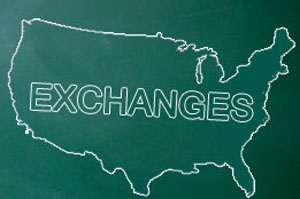Sometimes there really are economies of scale. And the nation’s health insurance exchanges may be a case in point.
 As rocky as its rollout was, it cost the federal exchange, healthcare.gov, an average of $647 of federal tax dollars to sign up each enrollee, according to a new report. It cost an average of $1,503 – well over twice as much – to sign up each person in the 15 exchanges run by individual states and Washington, D.C.
As rocky as its rollout was, it cost the federal exchange, healthcare.gov, an average of $647 of federal tax dollars to sign up each enrollee, according to a new report. It cost an average of $1,503 – well over twice as much – to sign up each person in the 15 exchanges run by individual states and Washington, D.C.
The report, released Wednesday, was compiled using data from federal enrollment figures and federal exchange funding for both the federal and state exchanges. It was written by Jay Angoff, a former Missouri Insurance Commissioner and one-time director of the Health and Human Services office in charge of implementing the health exchange program.
Even California, the most efficient of the state-run exchanges, at $758 per enrollee, still spent more than the average in the federal exchange. And California was the only state-run exchange with a per-person average under $1,000.
Hawaii, with a combination of a poorly-functioning website, a small population overall, and a small population of uninsured, brought up the rear in the study. It cost the Aloha State an average of $23,899 per enrollee covered. Washington D.C. came in next to last at $12,467 per person.
What was not expected, said Angoff in an interview, is that the five states whose governors and/or legislatures were among the most adamant about resisting the Affordable Care Act — Florida, Texas, Georgia, Virginia, and Michigan — ended up with the lowest per-person enrollee costs. Florida’s cost per enrollee was just $76; Texas’ was $102, and Michigan’s $427.
“The states that fought the ACA the hardest ended up with exchanges that have been very efficient,” he said.
All of the states with very high per-enrollee costs have one thing in common — relatively small populations. Yet it took millions of dollars to set up each exchange, so the smaller states couldn’t spread the costs. “Below some size, it doesn’t make sense for a state to run its own exchange,” Angoff said.
For example, “Hawaii got $200 million in grant funding,” he said. “For a state of a little less than 1.4 million,” it enrolled 8,592 people. At the same time, New York, with 19.7 million people, “got a little more than twice as much money” — $429 million — and enrolled 370,000 people.
Angoff said it does make sense to let states whose exchanges are functioning well to continue, but the federal government might want to reconsider letting other states establish their own exchanges, and encourage those whose exchanges aren’t doing so well to become part of healthcare.gov.
Oregon, for example, whose website failed somewhat spectacularly, and whose exchange is now under investigation by the FBI, according to The Oregonian, has already decided to join the federal exchange.
Maryland, on the other hand, which has also suffered from serious problems with its exchange, has decided to retool using technology pioneered by Connecticut.
“If a state exchange is working, great,” Angoff said. But if not, “does it make any sense to throw good money after bad?”






